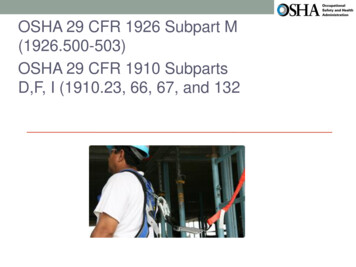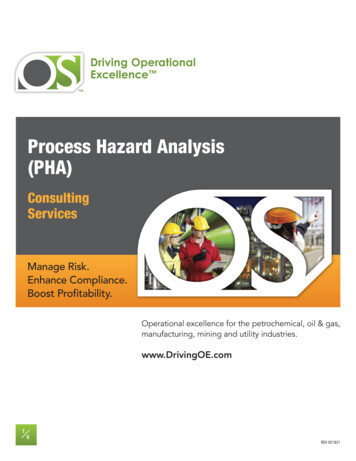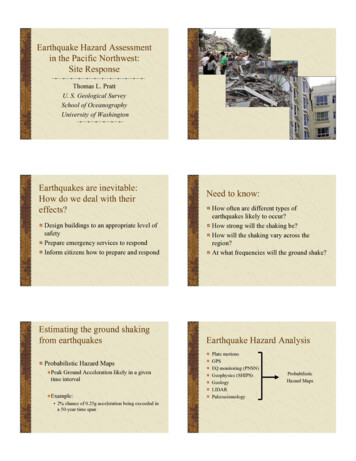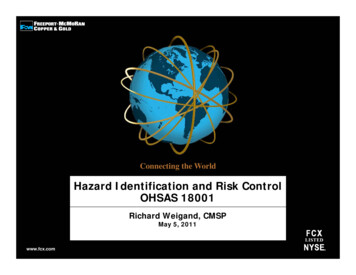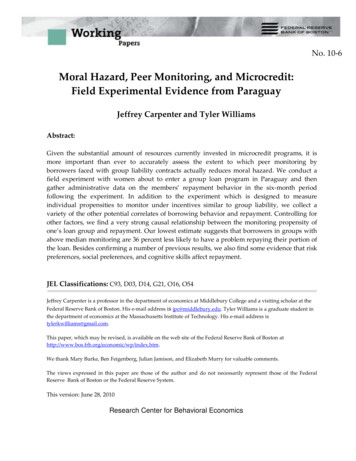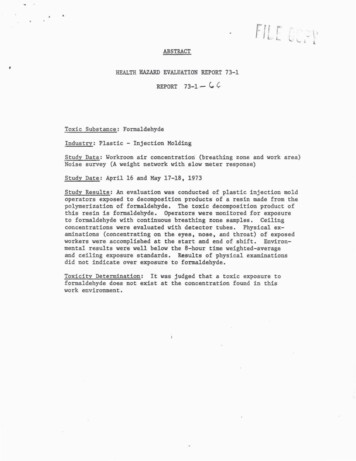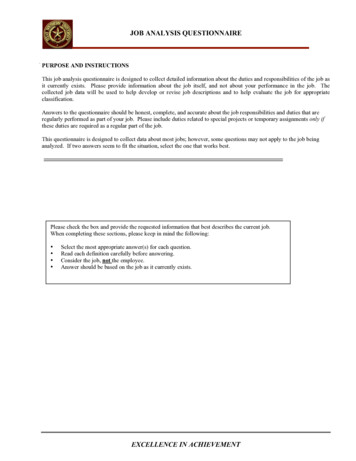
Transcription
Job Hazard AnalysisOSHA 30712002 (Revised)
Job Hazard AnalysisU.S. Department of LaborOccupational Safety and Health AdministrationOSHA 30712002 (Revised)
ContentsWho needs to read this booklet? . 1What is a hazard? . 1What is a job hazard analysis? . 1Why is job hazard analysis important? . 2What is the value of a job hazard analysis? . 2What jobs are appropriate for a job hazard analysis? . 3Where do I begin? . 4How do I identify workplace hazards? . 6How do I correct or prevent any hazards? . 12What else do I need to know beforestarting a job hazard analysis? . 12Why should I review my job hazard analysis? . 13When is it appropriate to hire a professionalto conduct a job hazard analysis? . 14OSHA Assistance, Services, and Programs . 15How can OSHA help me? . 15How does safety and health program managementassistance help employers and employees? . 15What are state plans? . 16How can consultation assistance help employers? . 16Who can get consultationassistance and what does it cost? . 17Can OSHA assure privacy to an employerwho asks for consultation assistance? . 17i
Can an employer be cited for violationsafter receiving consultation assistance? . 18Does OSHA provide any incentives forseeking consultation assistance? . 18What are the Voluntary Protection Programs? . 18How does VPP work? . 19How does VPP help employers and employees? . 19How does OSHA monitor VPP sites? . 20Can OSHA inspect an employerwho is participating in the VPP? . 20How can a partnership with OSHAimprove worker safety and health? . 21What is OSHA’s Strategic PartnershipProgram (OSPP)? . 21What do OSPPs do? . 21What are the different kinds of OSPPs? . 22What are the benefits of participation in the OSPP? . 22Does OSHA have occupational safety andhealth training for employers and employees? . 23Does OSHA give money to organizationsfor training and education? . 24Does OSHA have other assistancematerials available? . 25What other publications does OSHA offer? . 25What do I do in case of an emergencyor if I need to file a complaint? . 26ii
OSHA Regional and Area Office Directory . 27OSHA-Approved Safety and Health Plans . 32OSHA Consultation Projects . 36Appendix 1 —Hazard Control Measures . 41Appendix 2 —Common Hazards and Hazard Descriptions . 43Appendix 3 —Sample Job Hazard Analysis Form . 46iii
Who needs to read this booklet?This booklet is for employers, foremen, and supervisors,but we encourage employees to use the information aswell to analyze their own jobs and recognize workplacehazards so they can report them to you. It explains whata job hazard analysis is and offers guidelines to help youconduct your own step-by-step analysis.What is a hazard?A hazard is the potential for harm. In practical terms,a hazard often is associated with a condition or activity that,if left uncontrolled, can result in an injury or illness. SeeAppendix 2 for a list of common hazards and descriptions.Identifying hazards and eliminating or controlling them asearly as possible will help prevent injuries and illnesses.What is a job hazard analysis?A job hazard analysis is a technique that focuses onjob tasks as a way to identify hazards before they occur.It focuses on the relationship between the worker, the task,the tools, and the work environment. Ideally, after youidentify uncontrolled hazards, you will take steps toeliminate or reduce them to an acceptable risk level.1
Why is job hazard analysis important?Many workers are injured and killed at the workplaceevery day in the United States. Safety and health can addvalue to your business, your job, and your life. You can helpprevent workplace injuries and illnesses by looking at yourworkplace operations, establishing proper job procedures,and ensuring that all employees are trained properly.One of the best ways to determine and establish properwork procedures is to conduct a job hazard analysis. A jobhazard analysis is one component of the larger commitmentof a safety and health management system. (See page 15for more information on safety and health managementsystems.)What is the value of a job hazard analysis?Supervisors can use the findings of a job hazard analysisto eliminate and prevent hazards in their workplaces.This is likely to result in fewer worker injuries and illnesses;safer, more effective work methods; reduced workers’compensation costs; and increased worker productivity.The analysis also can be a valuable tool for training newemployees in the steps required to perform their jobs safely.For a job hazard analysis to be effective, managementmust demonstrate its commitment to safety and health andfollow through to correct any uncontrolled hazards identified.Otherwise, management will lose credibility and employeesmay hesitate to go to management when dangerousconditions threaten them.2
What jobs are appropriatefor a job hazard analysis?A job hazard analysis can be conducted on many jobs inyour workplace. Priority should go to the following typesof jobs: Jobs with the highest injury or illness rates; Jobs with the potential to cause severe or disablinginjuries or illness, even if there is no history of previousaccidents; Jobs in which one simple human error could lead to asevere accident or injury; Jobs that are new to your operation or have undergonechanges in processes and procedures; and Jobs complex enough to require written instructions.3
Where do I begin?1. Involve your employees. It is very important toinvolve your employees in the hazard analysis process.They have a unique understanding of the job, and thisknowledge is invaluable for finding hazards. Involvingemployees will help minimize oversights, ensure aquality analysis, and get workers to “buy in” to thesolutions because they will share ownership in theirsafety and health program.2. Review your accident history. Review with youremployees your worksite’s history of accidents andoccupational illnesses that needed treatment, lossesthat required repair or replacement, and any “nearmisses” — events in which an accident or loss did notoccur,but could have. These events are indicators that theexisting hazard controls (if any) may not be adequateand deserve more scrutiny.3. Conduct a preliminary job review. Discuss withyour employees the hazards they know exist in theircurrent work and surroundings. Brainstorm with themfor ideas to eliminate or control those hazards.If any hazards exist that pose an immediate dangerto an employee’s life or health, take immediateaction to protect the worker. Any problems that canbe corrected easily should be corrected as soon aspossible. Do not wait to complete your job hazard analysis.This will demonstrate your commitment to safety andhealth and enable you to focus on the hazards andjobs that need more study because of their complexity.For those hazards determined to present unacceptablerisks, evaluate types of hazard controls. More informationabout hazard controls is found in Appendix 1.4
4. List, rank, and set priorities for hazardous jobs.List jobs with hazards that present unacceptable risks,based on those most likely to occur and with the mostsevere consequences. These jobs should be your firstpriority for analysis.5. Outline the steps or tasks. Nearly every job can bebroken down into job tasks or steps. When beginninga job hazard analysis, watch the employee perform thejob and list each step as the worker takes it. Be sureto record enough information to describe each jobaction without getting overly detailed. Avoid makingthe breakdown of steps so detailed that it becomesunnecessarily long or so broad that it does not includebasic steps. You may find it valuable to get input fromother workers who have performed the same job.Later, review the job steps with the employee to makesure you have not omitted something. Point out thatyou are evaluating the job itself, not the employee’s jobperformance. Include the employee in all phases ofthe analysis— from reviewing the job steps andprocedures to discussing uncontrolled hazards andrecommended solutions.Sometimes, in conducting a job hazard analysis,it may be helpful to photograph or videotape theworker performing the job. These visual records canbe handy references when doing a more detailedanalysis of the work.5
How do I identify workplace hazards?A job hazard analysis is an exercise in detective work. Yourgoal is to discover the following: What can go wrong? What are the consequences? How could it arise? What are other contributing factors? How likely is it that the hazard will occur?To make your job hazard analysis useful, documentthe answers to these questions in a consistent manner.Describing a hazard in this way helps to ensure that yourefforts to eliminate the hazard and implement hazard controlshelp target the most important contributors to the hazard.Good hazard scenarios describe: Where it is happening (environment), Who or what it is happening to (exposure), What precipitates the hazard (trigger), The outcome that would occur should it happen(consequence), and Any other contributing factors.A sample form found in Appendix 3 helps you organizeyour information to provide these details.Rarely is a hazard a simple case of one singular causeresulting in one singular effect. More frequently, many6
contributing factors tend to line up in a certain way to createthe hazard. Here is an example of a hazard scenario:In the metal shop (environment), while clearing asnag (trigger), a worker’s hand (exposure) comesinto contact with a rotating pulley. It pulls hishand into the machine and severs his fingers(consequences) quickly.To perform a job hazard analysis, you would ask: What can go wrong? The worker’s hand could comeinto contact with a rotating object that “catches” it andpulls it into the machine. What are the consequences? The worker couldreceive a severe injury and lose fingers and hands. How could it happen? The accident could happen asa result of the worker trying to clear a snag duringoperations or as part of a maintenance activity while thepulley is operating. Obviously, this hazard scenariocould not occurif the pulley is not rotating. What are other contributing factors? This hazardoccurs very quickly. It does not give the worker muchopportunity to recover or prevent it once his hand comesinto contact with the pulley. This is an important factor,because it helps you determine the severity andlikelihood of an accident when selecting appropriatehazard controls. Unfortunately, experience has shownthat training is not very effective in hazard control whentriggering events happen quickly because humans canreact only so quickly.7
How likely is it that the hazard will occur? Thisdetermination requires some judgment. If there havebeen “near-misses” or actual cases, then the likelihoodof a recurrence would be considered high. If thepulley is exposed and easily accessible, that also is aconsideration. In the example, the likelihood that thehazard will occur is high because there is no guardpreventing contact, and the operation is performedwhile the machine is running. By following the stepsin this example, you can organize your hazardanalysis activities.The examples that follow show how a job hazard analysiscan be used to identify the existing or potential hazards foreach basic step involved in grinding iron castings.Grinding Iron Castings: Job StepsStep 1. Reach into metal box to right of machine,grasp casting, and carry to wheel.Step 2. Push casting against wheel to grind off burr.Step 3. Place finished casting in box to left of machine.8
Example Job Hazard Analysis FormJob Location:Metal ShopAnalyst:Joe SafetyDate:Task Description: Worker reaches into metal box to theright of the machine, grasps a 15-pound casting andcarries it to grinding wheel. Worker grinds 20 to 30castings per hour.Hazard Description: Picking up a casting, the employeecould drop it onto his foot. The casting’s weight and heightcould seriously injure the worker’s foot or toes.Hazard Controls:1. Remove castings from the box and place them on atable next to the grinder.2. Wear steel-toe shoes with arch protection.3. Change protective gloves that allow a better grip.4. Use a device to pick up castings.9
Job Location:Metal ShopAnalyst:Joe SafetyDate:Task Description: Worker reaches into metal box to theright of the machine, grasps a 15-pound casting andcarries it to grinding wheel. Worker grinds 20 to 30castings per hour.Hazard Description: Castings have sharp burrs andedges that can cause severe lacerations.Hazard Controls:1. Use a device such as a clamp to pick up castings.2. Wear cut-resistant gloves that allow a go
U.S. Department of Labor Occupational Safety and Health Administration OSHA 3071 2002 (Revised) Job Hazard Analysis


